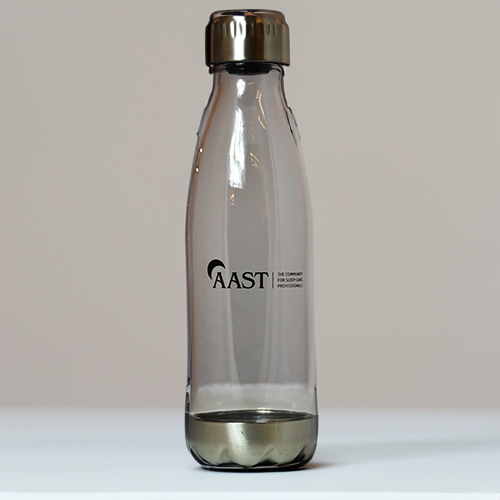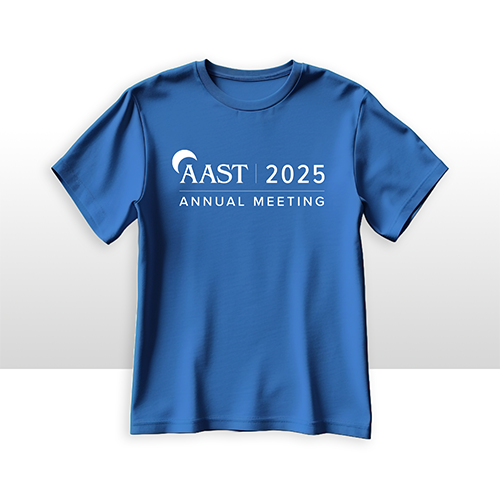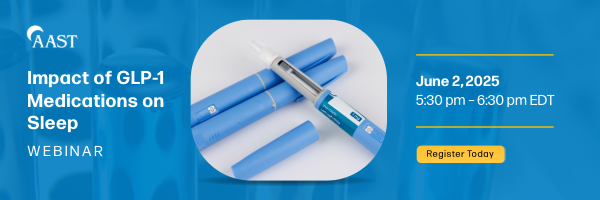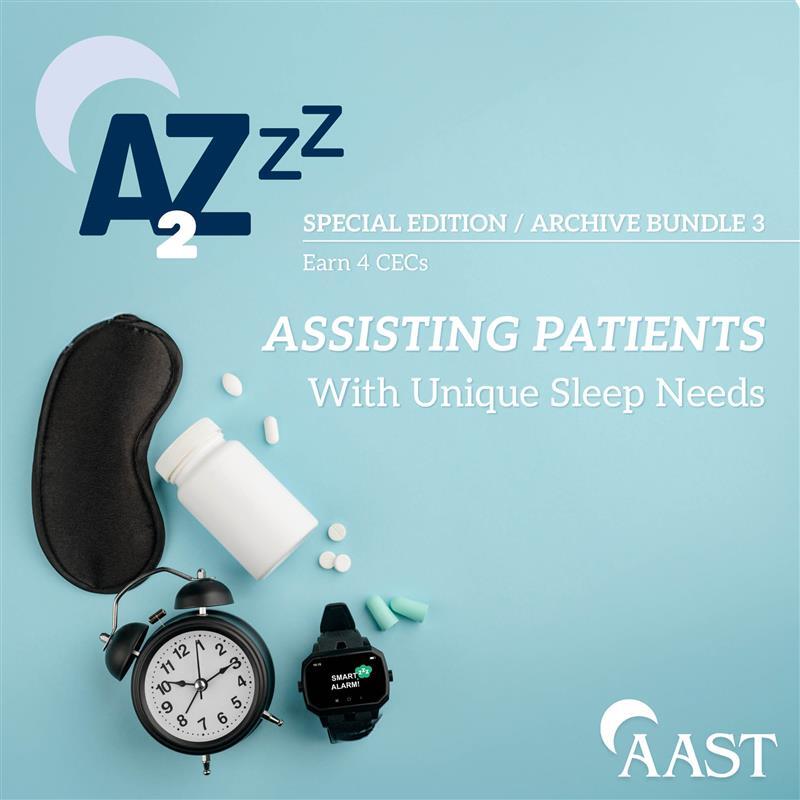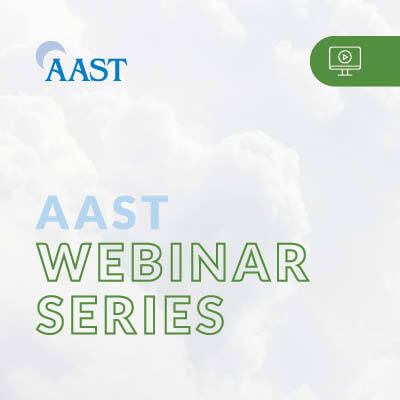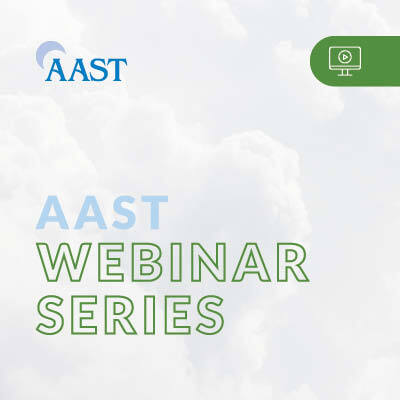
Catalog
105 Results
-
Contains 2 Component(s)
AAST Water Bottle
- Introduction
- Anatomy and Physiology of the Respiratory System
- CPAP & BPAP
- AVS
- NPPV - AVAPS
- AVAPS-AE
- Knowledge Check Answers
AAST Water Bottle - Stay refreshed and represent your profession with the AAST Water Bottle. Designed for durability and convenience, this sleek, lightweight bottle is perfect for busy sleep technologists on the move. Whether you're at the clinic, at a conference, or on a quick break, this bottle helps you stay hydrated in style.
-
Register
- Non-member - $20
- Member - $10
- More Information
-
Contains 2 Component(s)
AAST Mug
AAST Mug $20 NM | $10 M Start your day the right way—with the perfect cup in hand. The AAST Mug combines style and function, offering a sleek, durable design that’s ideal for home, office, or on-the-go use. Crafted from high-quality ceramic, this cup features a glossy white finish with the official AAST logo, making it a proud addition to any sleep technologist’s collection.
-
Register
- Non-member - $20
- Member - $10
- More Information
-
Register
-
Contains 3 Component(s)
AAST 2025 Annual Meeting T-Shirt
AAST 2025 Annual Meeting T-Shirt - Celebrate connection, community, and professional pride with the official AAST 2025 Annual Meeting T-Shirt. Whether you're attending in person or showing your support from afar, this commemorative shirt is a must-have keepsake. Made with soft, breathable fabric and designed for everyday comfort, it’s perfect for showcasing your role in the sleep technology profession. Available in S-M-L-XL-XXL-XXXL, limited quantities)
-
Register
- Non-member - $30
- Member - $15
- More Information
-
Register
-
Contains 4 Component(s), Includes Credits Recorded On: 06/02/2025
Impact of GLP-1 Medications on Sleep (A31974)
Objectives for the presentation:
1. Understand the role of weight in OSA pathogenesis
2. Review mechanisms of GLP-1 medications for weight loss
3. Understand the latest data and recommendations on GLP-1 medications for OSA
4. Examine impacts of GLP-1 on current OSA therapies
-
Register
- Non-member - $30
- Member - Free!
- More Information
-
Register
-
Contains 3 Component(s), Includes Credits
A2Zzz 2025 Volume 34 Number 1 (A31959)
The following articles can be found in the A2Zzz 2025 Volume 34 Number 1 (A31959) of A2Zzz:
Leadership Series: Adding Value by Renae Davis, RPSGT, CCSH, and Ryan Lott, MBA, RPSGT
Technical Corner: An Essential AI Roadmap for the Modern Sleep Technologist by Matthew Anastasi, RPSGT, RST, FAAST
Is the Future Now? Sleep Technology Unleashed by Robert Miller, RPSGT
Zepbound Officially Enters the Sleep Apnea Therapy Market by Bretton Lane, BS, RPSGT, President and chief operating officer at BetterNight
2025 and Beyond Mike Stanton, RPSGT, CCSH
Updates to Claiming CECs From A2Zzz:
AAST members looking to claim their free AAST continuing education credits (CECs) from reading the latest issue of A2Zzz will need to complete a knowledge assessment in the Learning Center. Upon completion of the knowledge assessment, AAST members will be awarded their four free AAST CECs.
-
Register
- Member - Free!
- More Information
-
Register
-
Contains 3 Component(s), Includes Credits
A2Zzz Special Edition Archive Bundle 3: Assisting Patients with Unique Sleep Needs (A31961)
The following articles can be found in the A2Zzz Special Edition Archive Bundle 3: Assisting Patients with Unique Sleep Needs (A31961)
The Unique Sleep Needs of Women
Interview by Alexa Schlosser
2019 Issue 4Managing Sleep Problems in People With LONG COVID
Regina Patrick, RPSGT, RST
2023 Issue 3TRAUMA ASSOCIATED SLEEP DISORDER: How PTSD Patients Might Be Suffering From This New, Proposed Parasomnia
Kate Jacobson
2021 Issue 1Possible Link Between OBSTRUCTIVE SLEEP APNEA and the SENSE OF SMELL
Regina Patrick, RPSGT, RST
2019 Issue 1Updates to Claiming CECs From A2Zzz:
AAST members looking to claim their free AAST continuing education credits (CECs) from reading the special edition of A2Zzz will need to complete a knowledge assessment in the Learning Center. Upon completion of the knowledge assessment, AAST members will be awarded four free AAST CECs.
-
Register
- Non-member - $100
- Member - $25
- More Information
-
Register
-
Contains 3 Component(s), Includes Credits
A2Zzz Special Edition Archive Bundle 2: Advancing Chronic Sleep Care (A31960)
The following articles can be found in the A2Zzz Special Edition Archive Bundle 2: Advancing Chronic Sleep Care (A31960)
The Reluctant Patient: Simplified Motivational Enhancement Therapy to Improve CPAP Adherence
Susan Hoefs, RPSGT, CCSH
2023 Issue 2
What’s New in Central Sleep Apnea: Phrenic Nerve Stimulation
Seamus Jackson and Cindy Crosby, MS, MBA, RPSGT
2020 Issue 1
Obstructive Sleep Apnea and Stroke
Monica Roselli
2020 Issue 4
SPONSORED: Is the Apnea-hypopnea Index the Best Metric for Evaluating Obstructive Sleep Apnea?
Snorri Helgason
2023 Issue 4Updates to Claiming CECs From A2Zzz:
AAST members looking to claim their free AAST continuing education credits (CECs) from reading the special edition of A2Zzz will need to complete a knowledge assessment in the Learning Center. Upon completion of the knowledge assessment, AAST members will be awarded four free AAST CECs.
-
Register
- Non-member - $100
- Member - $25
- More Information
-
Register
-
Contains 4 Component(s), Includes Credits Recorded On: 05/05/2025
The Advantage of a HGNS Program (A31965) Hypoglossal nerve stimulator (HGNS) is a common treatment for obstructive sleep apnea.
- What kind of support do you need to run a successful HGNS (Inspire) program?
- Identifying patients that may benefit from this therapy
- Understanding of structured Care Pathway with Certification for clinicians
- Knowing there are next steps and we don’t stop until the patient and provider are satisfied with the results
-
Register
- Non-member - $30
- Member - Free!
- More Information
-
Contains 4 Component(s), Includes Credits Recorded On: 03/24/2025
- Understand the indication for bilevel, ASV and VAPs therapies - Learn about optimal therapy settings based on patient response - Recognized and address common issues with therapy *Hypoventilation *Hyperventilation *Mask Leak - Document observed signs, efforts to resolve issues and outcomes during titration study.
Objectives:
- Differentiate between PAP titration protocols for OSA, CSA, and NIV indicated conditions such as hypoventilation syndromes.
- Interpret polysomnographic data to guide the adjustment of advanced PAP modalities, including ASV, BiPAP-ST, and volume-assured pressure support.
- Formulate individualized titration strategies for patients with central sleep apnea and those requiring non-invasive ventilation, based on clinical presentation and comorbidities.
-
Register
- Non-member - $30
- Member - Free!
- More Information
-
Contains 3 Component(s), Includes Credits
A2Zzz Special Edition Archive Bundle 1: Understanding Pediatric Sleep (A31938)
The following articles can be found in the A2Zzz Special Edition Archive Bundle 1: Understanding Pediatric Sleep (A31938):
- A TALE OF TWO TERRORS: Night Terrors in Children and Adults by Tamara Sellman, RPSGT, CCSH
- Treatment of RESIDUAL OSA IN CHILDREN by Regina Patrick, RPSGT, RST
- Pediatric Sleep Problems by Joseph Anderson, RPFT, CRT-NPS, RPSGT, RST, CCSH
- The Importance of Educating Children and Teenagers About Sleep Hygiene By Karla J. Thompson, BA, RPSGT, CCSH
Updates to Claiming CECs From A2Zzz:
AAST members looking to claim their free AAST continuing education credits (CECs) from reading the special edition of A2Zzz will need to complete a knowledge assessment in the Learning Center. Upon completion of the knowledge assessment, AAST members will be awarded their four free AAST CECs.
-
Register
- Non-member - $100
- Member - Free!
- More Information







